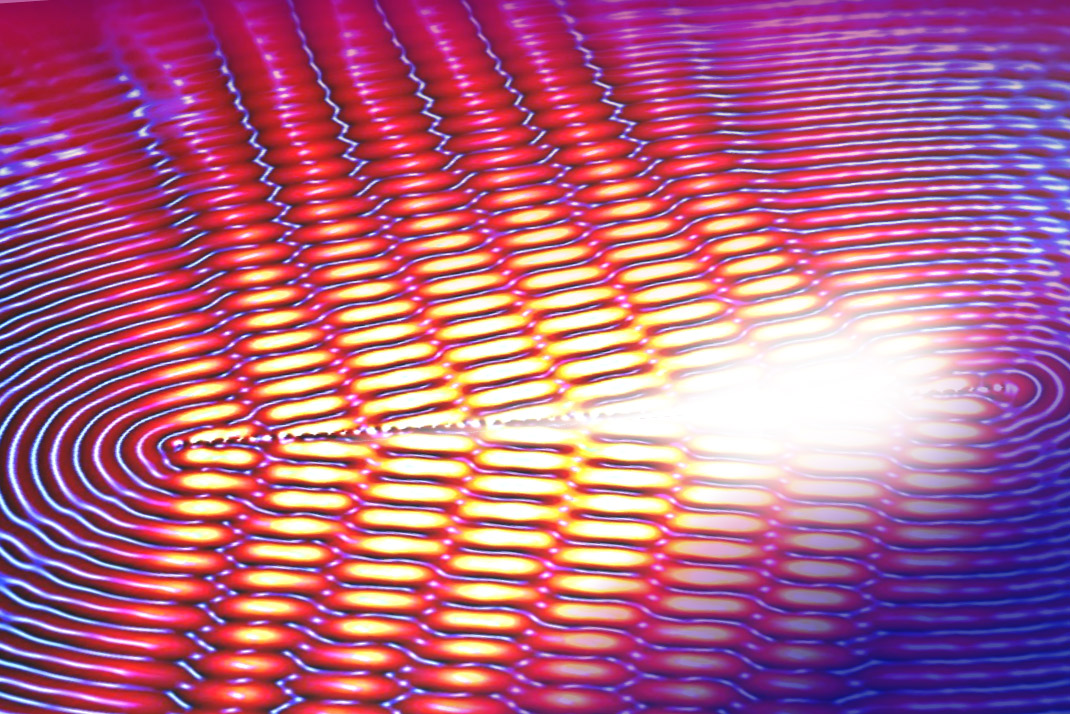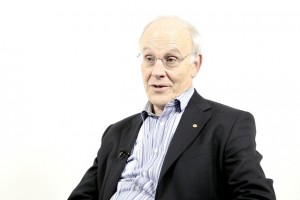Quantum Chromodynamics
Nobel Prize laureate David Gross on Rutherford experiments, asymptotic freedom, and the origin of the particle...

Federico Capasso is Robert L. Wallace Professor of Applied Physics and Vinton Hayes Senior Research Fellow in Electrical Engineering. Serious Science has asked Prof. Capasso about flat lenses and artificial nanostructures created with the use of the Cherenkov effect.
In which research areas are you working now?
We have some really exciting developments in flat optics and also some very interesting new physics related to nanophotonics. Generally it’s nanophotonics we have been working on for a number of years. Particular things I can tell you about is recent developments in flat optics and also about this interesting new physics with nanotechnology. We had recently science paper in Nature Nanotechnology in these developments.
Let me start with flat optics. The big picture is the following. Let’s take lens technology. As you know, lenses normally have a curvature. We generally talk about spherical lenses, cylindrical lenses. In the result of the curvature, lenses have aberration. It means that not all the light that hits a lens gets actually focused in the same point. The point is that lenses, depending on the wavelength, focus different colours in different points. So what we have shown that if you make lenses that are flat, you can make a lense which is free of aberrations. Basically, when all the light gets focused in one point, and different wavelengths, different colours, get focused in the same point.
Now, modern lenses, of course, can correct these defects, but you know that to make it you have to put several lenses one after another. That’s why if you look at a typical high quality camera, you’ll see that the objective is thick. It is only so thick, because you have multiple lenses.
Technically, we have corrected chromatic aberration. Again, if you try to do it with regular lenses, you will have to put several of them one after another. Let me give you a simple illustration. If I want to have two colours focused in the same spot, with a regular lens I have to use two lenses. If I want to focus three colours, I have to have three wavelengths. Is I want four colours – four wavelengths. Once you’ve corrected abberation for four wavelengths, you’ve basically corrected it for practically all the visible light.
So this is significant, because if you now have flat optics, you can make things thinner, smaller, and overall for less cost. And there are now many companies that are seriously looking at this. So, this is a very interesting development.The question is, if I have a flat surface, how can I allow it to focus light? Because a normal lens focuses light, because it is actually curved. So the trick is to nanostructure the surface of the lens with many elements. You can call them antennas or resonators. These do not have to be metallic, in fact, in our recent structure we use dielectric material, not metal. And they are designed so that all the optical rays that come off the lens get focused in the same point. Particularly, we’ve designed a lens that focuses three different wavelengths in the same point, and we have demonstrated it.
I can tell you now about another development, which is purely physics. We also do fun stuff just for the sake of it. This is a recent thing, it’s just been in Nature Nanotechnology this Monday. The idea is the following. You are familiar with things such as sonic boom – if you have a plain that moves at a velocity which is higher than the velocity of sounds, you actually create a sonic wave which is called a sonic boom. This is very general type of phenomenon that appears in many different areas of physics. The first one who thought of it was the famous scientist of the nineteenth century, lord Kelvin. He was an accomplished sailor. He noticed that if a boat exceeds a certain speed, you will form wakes. Also, if you have a duck that swims in a natural pond, if the duck moves a bit faster, it’ll form these wakes. If you take now an electrical charge that moves through a liquid, we know the charged particles’ speed exceeds the speed of light in the liquid, they will form a wake. And this is called Cherenkov effect.

All these phenomena have the common physics. The common physics is that if the perturbation moves through a medium with a speed higher than the so called phase velocity of light in the actual medium, the object that is moving will emit wakes. And these wakes come off at a certain angle, which depends on the ratio of the speed of the object to the speed of the wave.
So this is a very general phenomenon, it’s remarkable that it appears in various areas of physics. We have recently discovered another manifestation: we can create wakes on the surface of a metal by exciting surface wakes. We have shown that depending on the nanostructure of the surface we can engineer this effect, we can change the way the wakes look. So, it shows the power of nanotechnology in engineering, new optical phenomena at nanoscale. It’s conceptually very interesting and it’s intriguing that it relates to many different areas of physics.
The example I gave you is the case of acoustics: if you have a plane moving through a medium like air, and the velocity of the plane exceeds the speed of sound, you have a sonic boom, which is a shock wave. A shock wave is a natural wake. What happens is that these wakes are emitted on the surface of a cone. In this case, there is a cone of sound behind the moving plane.
In the case of the Cherenkov effect you have a charged particle, it could be a proton or an electron moving in a natural liquid. If the velocity of a particle exceeds that of light of that in the medium, it’s called phase velocity, then the particle will emit this cone of light, not of sound, but of light.
In the case of a duck, because it is a surface, you’re not talking about a cone, but a triangle. And the same for a boat. In our work it’s the surface effect. So we generate wakes of light on a natural surface, and by structuring the surface at the nanoscale we can actually engineer these wakes, we can design them, which is a very interesting effect.
What practical use can it have?
None. Right now I have no idea. It’s both a good and a bad question at the same time. It is always valid to us. But we know that there is a lot of science that when we do it we just don’t know if there ever going to be an application. And I don’t think there will be. It’s just very interesting. It shows these very nice physics and it illustrates what you can do with nanotechnology – actually control light waves. In this sense, it can generate new interesting thinking, you know, new directions of research.
How do you think, in which direction will this research go in the nearest future?
More in general, and this is an exciting area of research, when we go back to flat optics now. What I can do now is engineer a surface by structuring it at a sub-wavelength scale in such a way that if I hit the surface with a natural beam… You can ask a question: can you design a surface – I like to call it a metasurface, because it’s a structural surface – in such a way that deep in a certain incident wave I can create, for example, a vortex of light? The answer is yes, we’ve done it, we’ve published it in Science in 2012, and that started a whole field of research on metasurfaces.
So, I’m making a bold statement, but I am very confident. And if you tell me, “Federico, I want to create a strange beam” – for example, there are beams that have been postulated theoretically, but not demonstrated yet that are called ‘twisted beams’. They are like spaghetti of light that twist around themselves. So you can ask a question: can I now structure a surface artificially in such a way that if light hits it at a certain angle, I can create these twisted beams.
This is a whole area of work which is open that is called ‘structured light’. You can create, you can dream of very strange beams theoretically and then ask a question, “How can I generate them?” And I think this recent research we have published can be called from the physic’s point of view “Investigating structured light, and how to create it”, what kind of metasurface can we create actually in practice. It’s a wide open field, and it’s extremely exciting.
How do we calculate, how do we model new things in physics? We often come with a physical picture, we do a calculation, and then we see what comes about. And most of the times, if our guess is right, we come close to the answer. But sometimes the problems are so complicated that if you try to find the answer in a straightforward way, you will never get there, because computationally it can become very intense. And these problems are called inverse problems. The typical inverse problem is this: given a certain output, you have a certain output, so, you tell me, “Federico, create a twisted beam of light”. There are ways that I would do it, there are techniques that we are starting to work on with other groups. And this is called inverse problems, they are very famous for being very difficult to actually crack from the mathematical point of view.
How I can go the opposite way, so I can ask: what is the metasurface that can create these waves? Or it’s typical using actual scattering problem. Suppose I don’t know what scatters a natural particle. It is an atom, or a molecule, or a crystal – I don’t know. But I know the output that I want – I want to create a spherical wave by actual scattering, that’s easy to do, you don’t need a complex calculation. Then this inverse method allows you to go backwards, and the solution is then this so called potential that by scattering creates the particular wave of interest.
So I think with this problem that I’ve formulated before that inverse method will become very powerful to achieve what we now want to achieve that is: given a certain beam of light that I want to create, what do I have to build? And that is a big mathematical problem, it’s not easy to solve this.

Nobel Prize laureate David Gross on Rutherford experiments, asymptotic freedom, and the origin of the particle...

Neuroscientist Sylvain Baillet on CT scanning, the way MRI works, and other techniques that revolutionized med...

Physicist Joseph Formaggio on neutrino oscillations, the Standard Model, and nuclear burning cycle of young st...